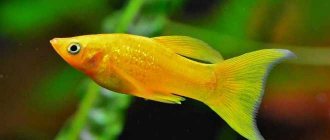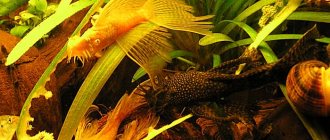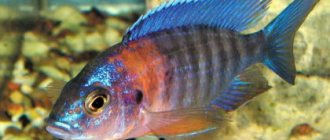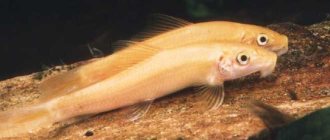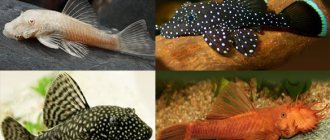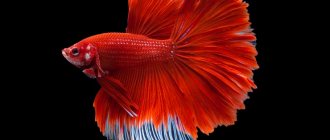5
(32)
The genus of catfish in the world of aquariums is represented by an incredibly wide variety. These fish are amazing in nature. They differ markedly from most species in habits, appearance, etc. However, even within their genus they are very different. For example, one of the brightest representatives of the family is the Ancistrus catfish.
Ancistrus is an excellent aquarium orderly.
Today he is the most popular among his relatives. This is explained by its unpretentiousness, thanks to which both beginners and more experienced aquarists keep this fish in their aquariums. But in addition, she has an interesting appearance, she is an excellent aquarium orderly and is quite curious in behavior.
Description
Dolichopterus var albino is a ray-finned fish belonging to the chain catfish family and the genus Ancistrus. They are also called albino gold or golden ancistrus. The Ancistrus genus includes 69 species, but albinos have gained high popularity due to their unusual color for catfish. The closest relative is ancistrus hoplogenys or star-shaped ancistrus.
They live in South and Central America in the Amazon River.
Suitable for beginner aquarists because the fish are unpretentious and tolerant of many mistakes in care.
Appearance
Albino catfish have a flattened body with a large head. Large lips, similar to suction cups, and whiskers stand out on the head, with the help of which the fish finds food at the bottom. At the ends of the lips there are hard growths that help the catfish eat hard algae from stones. Males have hard skin spines on their body and head. By this “crown”, females identify males who are stronger and more capable of procreation. Females have no needles at all or they are of reduced size.
In its natural environment, the golden catfish is considered a fairly large fish, reaching a size of 15–17 cm. When bred in aquariums, their size has decreased significantly - now it is difficult to find fish longer than 6 cm.
The color of the fish ranges from pale yellow and pink to rich lemon. Although the catfish looks harmless and vulnerable in appearance, it is protected by hard scales. The fins and tail are transparent with body-colored cartilage.
Behavior
Catfish have a calm character and a neutral attitude towards other inhabitants. But among a large flock of Ancistrus, fights occur among males. They are territorial and protect occupied territories. When keeping one male ancistrus and a flock of several females, there is no conflict.
The golden catfish Ancistrus is active at dusk, and during the day it hides in shady places.
Lifespan
Life expectancy in an aquarium is up to 5 years for males, up to 4 years for females.
Kinds
Today there are many varieties of ancistrus, which differ in color, fin shape and other characteristics. The following types are especially popular:
Common Ancistrus
The most common, they can be seen in every pet store. They have a dull grayish color with light spots. But at the same time they are as useful as possible and simple to maintain. In nature they live in the mountain rivers of South America, as well as in the Amazon;
Star view
Looks more mysterious and attractive. These catfish are black in color with many white dots. Their natural habitat is similar to that of common catfish. They can be found in the Rio Topajos basin. But, unlike their brothers, they prefer not only clean, but also warm water with a fast current. Star ancistrus have a slender body with a large head and impressive fins. The mouth also looks like a suction cup, allowing fish to cling to the surface during currents. Individuals live in aquarium conditions, as a rule, for about 10 years. The length is the same as ordinary ones, 10 cm. The gender differences are the same. Males have spines on their heads. As for water parameters, any water will do, but not too hard. However, it is better to maintain the biotope. In the natural reservoirs of South America, the water is quite soft and has a dark tint, since leaves and snags are constantly dissolving in it. Optimal acidity is 5.5-7. Temperature – 27-30, but can withstand even 34 degrees, but with good aeration;
Albino
Fundamentally, there are no differences in the conditions of detention. These are the same ordinary ancistrus, but the only difference is that they have a white color and red eyes. This is a form bred by breeders that is very popular. When bred, it combines well with its ordinary counterparts;
Golden albino
Likewise, the differences relate only to color. It is an albino subspecies but has a golden hue;
Red Ancistrus
Was recently released in Germany. Therefore, practically nothing is known about him yet. Many aquarium hobbyists consider this to be simply an offshoot of a common species;
Ancistrus Claro
These fish were named so due to the fact that they live naturally in the river of the same name. They reach a length of 8 cm. The color is almost the same, with the exception of more light spots. It is essentially a miniature common ancistrus;
Ancistrus multispinnis
They grow up to 12 cm and live in the Humboldt River. The body is dark gray with dark spots, like the fins;
Ancistrus ranunculus
Also lives in Brazil. But it differs significantly in that it grows up to 20 cm, that is, twice as much as the usual species;
Ancistrus Bolivianus
The name speaks for itself. Found naturally in Bolivia. They can reach 12 cm in length and are distinguished by a brownish color with yellow spots;
Ancistrus tamboensis
Size - 9 cm. The main difference is a lot of brown inclusions throughout the body, due to which the catfish immediately catches the eye and overall looks quite unusual;
Content
Introducing catfish into an aquarium does not mean that less care is required for it and its inhabitants. Catfish do not clean the entire aquarium, but only certain types of algae. Dirt, food debris, and fish waste remain in the tank and begin to rot, so the aquarist must still monitor the cleanliness of the water and replace ¼ of the tank’s volume weekly.
They do not eat golden ancistrus and blackbeard algae.
Aquarium
Ancistrus yellow does not feel comfortable in small and small aquariums. For 3 representatives of the species you will need an aquarium of 60 liters. In their natural environment, fish live in cool water with moderate currents and aeration. Similar conditions must be created in the aquarium.
Water parameters
- Water temperature is 20–24 degrees.
- It is insensitive to hardness, so any values are suitable.
- Acidity 6.5–7.6 pH.
- Anubias.
- Crinum.
- Marsilia.
- Bolbitis Gedeloti.
- Vindelov fern.
- Aponogeton rigidifolia.
- Echinodorus schlutera.
- Lindernia rotundifolia.
Plants
Catfish clear algae from the bottom, stones, walls of the aquarium and plant leaves. Therefore, aquarists are not always sure whether the plants will be damaged during such cleaning. But catfish are careful in their work and most often the leaves remain unharmed. But still, you should not plant fragile vegetation with thin foliage that can be easily damaged next to them: cabomba, sinema, peristolite.
The catfish is not inclined to dig up the roots, but if the rhizomes are poorly covered and close to the surface, the catfish is accidentally able to dig them out.
Almost all types of aquarium plants are suitable for catfish, but hard-leaved plants with a strong root system will feel best:
Priming
Catfish have highly sensitive antennae, with the help of which they find food. Therefore, they are easily damaged by the sharp edges of stones and snags.
A good choice of substrate would be small pebbles or gravel, in which the particles are rounded and devoid of jagged edges. River sand is also suitable. Do not use large stones as soil, because food will accumulate and rot in the cracks.
Equipment
If there are few or no plants in the aquarium, then for the aquarium albino to live comfortably, you will need to install a filtration system, because they are sensitive to nitrates in the water, which is formed during the decomposition of waste and food debris.
A compressor will also not be superfluous, because if there is a lack of oxygen in the water, fish swimming near the surface are still able to replenish it on their own, but bottom-dwelling fish feel oxygen starvation. Therefore, to be sure that catfish always have enough oxygen in the water, it is necessary to install an aeration device.
Lighting
Golden catfish are not too sensitive to light, but do not like bright direct rays. A more comfortable option would be diffused light with shaded areas where, if necessary, the catfish will hide to rest.
Tool of the cunning catfish
All stickers, both small and large, have one thing in common - a sucker. The modified mouth helps the fish cling to flat surfaces, scraping plaque from them using a special grater that acts as teeth.
To make it more convenient to collect algae, evolution endowed the suckers with powerful jaw muscles, as well as a strong and massive head. At the same time, the body of the catfish itself is covered with keratinized scales, which formed the basis for the name of the species. Chain catfish also took care of their protection. To prevent the passive consumer of algae from being distracted from his meal by predators, he grew strong spines on his gills.
The body of the fish itself has a streamlined shape and a flat abdomen. For convenience and speed of movement, it is equipped with strong pectoral fins. Thanks to them, the fish can overcome the strongest river currents. Moreover, clingy fish love fast flows of water so much that even in captivity they need an artificially created current.
To move along surfaces, the catfish uses the dorsal and caudal fin. If the aquarium is not equipped with a flow simulator, the fish moves using its tail.
To move along surfaces, the catfish uses the dorsal and caudal fin.
Feeding
In their natural environment, ancistrus feed on algae, the remains of protein food on the bottom, and, less often, plant food. It is because of their ability to clean the aquarium of algae that aquarists most often keep catfish, believing that this allows them to monitor the aquarium less. Catfish need extra food. When moving into a new aquarium, ancistrus feed only on algae, but they quickly clear the aquarium and begin to starve without additional food.
Catfish are not picky and feed on frozen, live and dry food. But do not overfeed them with protein foods, this will negatively affect their health. They especially like the tubifex and bloodworms. But it is still advisable to use frozen food, because this is how harmful microorganisms die.
White ancistrus have a small mouth, so pellets and food particles should be small in size. If the aquarium contains other fish that live in the upper and middle layers of water, then the catfish may not have enough food, which is eaten before reaching the bottom. To do this, purchase food specifically for bottom dwellers - it quickly sinks to the bottom.
Catfish, especially young ones, also like plant foods in their diet. Vegetables most often fed are zucchini, carrots, and cucumbers; Lettuce and spinach leaves are also added. If plant food is lighter than water and floats to the surface, it becomes heavier.
Remove uneaten food after 24 hours to prevent rotting and decomposition. Albino ancistrus catfish are fed 1–2 times a day.
Adviсe
- When keeping a flock, buy only one male to avoid skirmishes and fights.
- When choosing soil, purchase only rolled and smooth particles without chips.
- Place a driftwood in the aquarium. When it is cleaned, fish receive valuable lignin and cellulose, useful for proper digestion.
The albino aquarium catfish is suitable for experienced and beginner aquarists. For beginners, it is undemanding to environmental conditions. Experienced people buy them to clean the aquarium of algae and give it a bright appearance.
(Visited 536 times, 1 visits today)
Compatibility
Ancistrus albino has a peaceful character, so it is combined with all fish that do not harm it. This characteristic includes small and medium-sized fish. But they have poor compatibility with territorial, aggressive and predatory fish. Difficulties also arise when keeping a school of catfish together with several males. They will arrange skirmishes and fights for territory and females.
The fish are incompatible with heat-loving fish, because they themselves love low water temperatures.
| Compatible neighbors | Incompatible neighbors |
| Cockerels | Discus |
| Angelfish | Neons |
| Guppy | Mollies |
| Barbs | Helostomy |
| Labeo | Melanochromis |
| Tetras | |
| Danio | |
| Swordtails | |
| Pecilia |
Breeding
Under favorable conditions, sticky fish can spawn on their own. If we are talking about targeted breeding, you need to prepare a spacious spawning tank (from 40 liters) with a filter and an aerator. A couple of breeders are placed in it: the female must be larger than the male so that he does not kill her. The water temperature is increased by 2 degrees, a lot of protein is introduced into the diet, and the water is changed more often than usual. Females lay eggs in a secluded place, such as a tube. After successful spawning, it is placed in a separate jar. The male is removed after the offspring hatch.
Reproduction
Albino catfish reproduce easily and do not require special conditions. Sometimes this even becomes a problem, because without a lack of control over a school of catfish, they quickly increase in number.
When buying fish for breeding, there are 2 ways:
- Buy a flock of fry and wait until they grow up and form a pair on their own.
- Buy 2 adult fish, determining their gender in advance by appearance, and wait for offspring.
With the second method, it is advisable not to buy fish from the same aquarium, but to choose different points of sale. After all, the probability of inbreeding in the first case is too high and future offspring may be weak or non-viable, especially if the fish have been inbred for several generations.
For breeding, a large spawning tank of 50–100 liters with several shelters suitable for laying eggs is required.
Sex differences
Sex cannot be distinguished until adulthood. In adolescent male fish, a clear distinctive feature begins to form - a “crown” on the head of leathery outgrowths. In females it is absent or appears in the form of small outgrowths along the edges of the head.
Spawning
The female lays 25–55 eggs in a dark and protected place. It takes 4–7 days for the eggs to mature. The female is removed from the spawning area, and the male is left behind. In nature, all responsibilities for protecting the offspring are transferred to him. The male will not feed until the eggs hatch and become strong. When the yolk sac larvae become active and begin to explore the world, the male is removed and returned to the main aquarium.
The water in the spawning tank is replaced 3 times weekly. The fry are fed with crushed bloodworms, shrimp, and vegetation. The fry are moved to the rest of the inhabitants only when their size exceeds 1 cm.
Raising fry
When the fry begin to hatch from the yolk sacs, they are usually still in a common cluster. But gradually the current begins to carry them throughout the reservoir. They do not need complementary feeding for 2-5 days. It should be started only after the membrane has completely dissolved. Until then, its internal nutrients are enough for them.
As the first complementary food, special tablets for young animals are used. The fry attach themselves to them and gradually eat them completely. Later, you can add finely chopped plant food and catfish food.
The following composition is also suitable as a first complementary food:
- Artemia naupliia – 50%;
- raw scalded green peas - 25%;
- chopped cauliflower - 25%.
The prepared mixture is mixed in equal proportions with an omelet of chicken eggs and milk and the finished product is laid out on the bottom.
After the first week, the fry are also fed with fresh Artemia nauplii, decapsulated eggs, scalded and chopped lettuce or spinach. In the second month of life, you can add a little crumb of wheat bread or oatmeal poured with boiling water to your diet.
The fry grow quickly, but they should be fed three times a day, with regular changes of at least 1/5 of the water. By the end of the first week, their length is about 12-18 mm, at 10 weeks - 30 mm. By the age of 6 months, juveniles are indistinguishable in size from adults.
From the age of three months, the feeding of the fry should become even more intense. The interval between feedings is reduced to three hours. At night, tubifex and bloodworms are placed on the bottom. This regimen should be maintained for up to 6 months.
Temperature optimal for growing ancistrus fry from eggs:
- +27…+28 °C - before the first complementary feeding;
- +25…+26 °C – up to 6 months;
- +22…+24 °C - after six months.
From three months of age, the salt content in water should be increased by 1 ppm.
Healthy fry are always in motion, have dense bodies, the color of which is slightly darker than that of adults.
Violation of the feeding regime is accompanied by weight loss in juveniles, pale body color, improper movements or hanging in vertical positions.
At the first unfavorable symptoms, you should change at least half the volume of water, provide rich aeration and adjust the diet.
Diseases
Ancistrus catfish are not in poor health, but some diseases also affect them. A common cause of disease is failure to maintain cleanliness and hygiene of the aquarium, untimely change of water, and rotting of food particles stuck between stones. Therefore, the best prevention of diseases in the aquarium inhabitants is timely cleaning and replacement of water.
In order to promptly determine the deteriorating health of ancistrus, you need to monitor the condition of your pets every day. If you recognize the disease in advance, it can be easily cured.
Symptoms of a sick catfish:
- Unusual behavior, uncharacteristic actions. Sluggish and inhibited or overly active behavior in combination with other symptoms indicates some kind of disturbance in the body.
- Change in fish color. More often the yellow color fades and loses its brightness. But this also happens after the spawning process, so this symptom is inaccurate.
- Poor appetite or its complete absence. Healthy fish are always ready to feed and swim to the place of food. And the patient remains in the shelter and does not touch the food.
- The formation of unhealthy plaque on the skin and scales.
Fish with one or more symptoms are separated from the others. Most often, catfish are affected by fin rot, swim bladder disorder and bacterial diseases.
Reviews
Aquarists speak positively about golden ancistrus, because they are unpretentious and peaceful neighbors for other inhabitants. They also allow you to less frequently clean the walls of aquariums from algae and reproduce easily. But sometimes cases occur when catfish spoil the thin leaves of a plant. Some aquarists are also upset that the catfish rarely comes out into the light, hides in shelters all the time and is active only at night.
